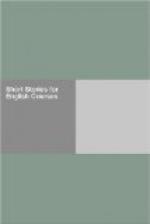“What?—sunrise?”
“Nonsense! no!—the bug. It is of a brilliant gold color—about the size of a large hickory-nut—with two jet black spots near one extremity of the back, another, somewhat longer, at the other. The antennae are—”
“Dey aint no tin in him, Massa Will, I keep a-tellin’ on you,” here interrupted Jupiter; “de bug is a goole-bug, solid, ebery bit of him, inside and all, sep him wing—neber feel half so hebby a bug in my life.”
“Well, suppose it is, Jup,” replied Legrand, somewhat more earnestly, it seemed to me, than the case demanded, “is that any reason for your letting the birds burn? The color”—here he turned to me—“is really almost enough to warrant Jupiter’s idea. You never saw a more brilliant metallic lustre than the scales emit— but of this you cannot judge till to-morrow. In the mean time I can give you some idea of the shape.” Saying this, he seated himself at a small table, on which were a pen and ink, but no paper. He looked for some in a drawer, but found none.
“Never mind,” said he at length, “this will answer;” and he drew from his waistcoat pocket a scrap of what I took to be very dirty foolscap, and made upon it a rough drawing with the pen. While he did this, I retained my seat by the fire, for I was still chilly. When the design was complete, he handed it to me without rising. As I received it, a low growl was heard, succeeded by a scratching at the door. Jupiter opened it, and a large Newfoundland, belonging to Legrand, rushed in, leaped upon my shoulders, and loaded me with caresses; for I had shown him much attention during previous visits. When his gambols were over, I looked at the paper, and, to speak the truth, found myself not a little puzzled at what my friend had depicted.
“Well!” I said, after contemplating it for some minutes, “this is a strange scarabaeus, I must confess; new to me: never saw anything like it before—unless it was a skull, or a death’s-head, which it more nearly resembles than anything else that has come under my observation.”
“A death’s-head!” echoed Legrand—“Oh—yes—well, it has something of that appearance upon paper, no doubt. The two upper black spots look like eyes, eh? and the longer one at the bottom like a mouth —and then the shape of the whole is oval.”
“Perhaps so,” said I; “but, Legrand, I fear you are no artist. I must wait until I see the beetle itself, if I am to form any idea of its personal appearance.”
“Well, I don’t know,” said he, a little nettled, “I draw tolerably—should do it at least—have had good masters, and flatter myself that I am not quite a blockhead.”
“But, my dear fellow, you are joking then,” said I, “this is a very passable skull,—indeed, I may say that it is a very excellent skull, according to the vulgar notions about such specimens of physiology—and your scarabaeus must be the queerest scarabaeus in the world if it resembles it. Why, we may get up a very thrilling bit of superstition upon this hint. I presume you will call the bug scarabaeus caput hominis, or something of that kind—there are many similar titles in the Natural Histories. But where are the antennae you spoke of?”




